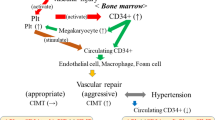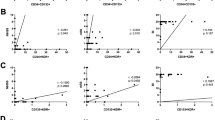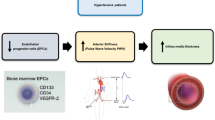Abstract
Populations of peripheral blood CD34+ cells comprise precursors of endothelial cells. These precursors are crucial to cardiovascular homeostasis. Hypertension, as one of the main risk factors for cardiovascular disease, is associated with the loss of endothelium structural integrity and its functional impairment. The aim of our study was to evaluate the subsets of endothelial precursor cells in patients with newly diagnosed arterial hypertension. Twenty-four newly diagnosed, previously untreated hypertensive patients aged 59.5±12.5 years, were enrolled into the study group, whereas the control group comprised 45 healthy subjects, 55.5±10.0 years old. Endothelial progenitor cells (EPCs) were analysed by flow cytometry. The results showed that hypertensive patients were characterized by a significantly higher percentage and number of the CD34+ cells and simultaneously less differentiated CD34+CD45dim/negCD133+ progenitors. The percentage and number of CD34+CD45negVEGFR2+ and CD34+CD45negCD133+VEGFR2+ cells were not different from the control group. Moreover, patients had a significantly lower percentage and number of the CD34+CD45negVEGFR2+CXCR4+ and CD34+CD45negVEGFR2+ICAM-1+ cells than healthy individuals. These changes were paralleled by early symptoms of nephropathy, that is, lower glomerular filtration rate (GFR) values and borderline micro albuminuria. Our results indicate that an elevation in the number of less differentiated progenitors may be a mechanism compensating for defects of migration and adhesion, present in a more differentiated subset.
This is a preview of subscription content, access via your institution
Access options
Subscribe to this journal
Receive 12 digital issues and online access to articles
$119.00 per year
only $9.92 per issue
Buy this article
- Purchase on Springer Link
- Instant access to full article PDF
Prices may be subject to local taxes which are calculated during checkout


Similar content being viewed by others
References
Delva P, Degana M, Vallerioa P, Arosiob E, Minuza P, Amena G et al. Endothelial progenitor cells in patients with essential hypertension. J Hypertens 2007; 25: 127–132.
Urbich C, Dimmeler S . Endothelial progenitor cells: characterization and role in vascular biology. Circ Res 2004; 95: 343–353.
Fadini GP, Vigili de Kreutzenberg S, Coracina A, Baesso I, Agostini C, Tiengo A et al. Circulating CD34+ cells, metabolic syndrome, and cardiovascular risk. Eur Heart J 2006; 27: 2247–2255.
Gari M . Identification of circulating endothelial cells in peripheral blood. Res J Med Sci 2011; 5: 262–268.
Asahara T, Murohara T, Sullivan A, Silver M, van der Zee R, Li T et al. Isolation of putative progenitor endothelial cells for angiogenesis. Science 1997; 275: 964–967.
Khakoo A, Finkel T . Endothelial progenitor cells. Annu Rev Med 2005; 56: 79–101.
George A, Bangalore-Prakash P, Rajoria S, Suriano R, Shanmugam A, Mittelman A et al. Endothelial progenitor cell biology in disease and tissue regeneration. J Hematol Oncol 2011; 4: 24–31.
Shantsila E, Watson T, Tse H-F, Lip G . New insights on endothelial progenitor cell subpopulations and their angiogenic properties. J Am Coll Cardiol 2008; 51: 669–671.
Oliveras A, Soler MJ, Martinez-Estrada OM, Vazquez S, Marco-Feliu D, Vila JS et al. Endothelial progenitor cells are reduced in refractory hypertension. J Hum Hypertens 2008; 22: 183–190.
Thuillez C, Richard V . Targeting endothelial dysfunction in hypertensive subjects. J Hum Hypertens 2005; 19: 21–25.
Ferroni P, Basili S, Paoletti V, Davi G . Endothelial dysfunction and oxidative stress in arterial hypertension. Nutr Metab Cardiovasc Dis 2006; 16: 222–233.
Pirro M, Schillaci G, Menecali C, Bagaglia F, Paltriccia R, Vaudo G et al. Reduced number of circulating endothelial progenitors and HOXA9 expression in CD34+ cells of hypertensive patients. J Hypertens 2007; 25: 2093–2099.
Ciuffetti G, Schillaci G, Innocente S, Lombardini R, Pasqualini L, Notaristefano S et al. Capillary rarefaction and abnormal cardiovascular reactivity in hypertension. J Hypertens 2003; 21: 2297–2303.
Antonios TF, Singer DR, Markandu ND, Mortimer PS, MacGregor GA . Rarefaction of skin capillaries in borderline essential hypertension suggests an early structural abnormality. Hypertension 1999; 34: 655–658.
Antonios TFT, Singer DRJ, Markandu ND, Mortimer PS, MacGregor GA . Structural skin capillary rarefaction in essential hypertension. Hypertension 1999; 33: 998–1001.
Li D, Liu Z, Wei J, Liu Y, Hu L . Contribution of endothelial progenitor cells to neovascularization. Int J Mol Med. 2012; 30: 1000–1006.
Balaji S, King A, Crombleholme T, Keswani S . The role of endothelial progenitor cells in postnatal vasculogenesis: implications for therapeutic neovascularization and wound healing. Adv Skin Wound Care 2012; 6: 283–295.
Caiado F, Dias S . Endothelial progenitor cells and integrins: adhesive needs. Fibrogenesis Tissue Repair 2012; 5: 4.
Bompais H, Chagraoui J, Canron X, Crisan M, Liu XH, Anjo A et al. Human endothelial cells derived from circulating progenitors display specific functional properties compared with mature vessel wall endothelial cells. Blood 2004; 103: 2577–2584.
Pelosi E, Castelli G, Martin-Padura I, Bordoni V, Santoro S, Conigliaro A et al. Human haemato-endothelial precursors: cord blood CD34+ cells produce haemogenic endothelium. PLoS ONE 2012; 7: e51109.
Rodriguez-Carrio J, De Paz B, Lopez P, Prado C, Alperi-Lopez M, Ballina-Garcia F et al. IFNa serum levels are associated with endothelial progenitor cells imbalance and disease features in rheumatoid arthritis patients. PLoS ONE 2014; 9: e86069.
Mula-Abed WA, Al Rasadi K, Al-Riyami D . Estimated glomerular filtration rate (eGFR): a serum creatinine-based test for the detection of chronic kidney disease and its impact on clinical practice. Oman Med J 2012; 2: 108–113.
Kidney Disease Improving Global Outcomes (KDIGO). Clinical Practice Guidelines for Evaluation and Management Chronic Kidney Disease. Kidney Inter. Suppl. 2013; 3: 1–150.
Grundy SM, Becker D, Clark LT, Cooper RS, Denke MA, Howard J et al. Third Report of the National Cholesterol Education Program (NCEP) Expert Panel on Detection, Evaluation, and Treatment of High Blood Cholesterol in Adults (Adult Treatment Panel III) final report. Circulation 2002; 106: 3143–3421.
Leone A, Valgimigli M, Giannico M, Zaccone V, Perfetti M, D’Amario D et al. From bone marrow to the arterial wall: the ongoing tale of endothelial progenitor cells. Eur Heart J 2009; 30: 890–899.
Basile D, Yoder M . Circulating and tissue resident endothelial progenitor cells. J Cell Physiol 2014; 229: 10–16.
Mandraffino G, Sardo MA, Riggio S, Loddo S, Imbalzano E, Alibrandi A et al. Circulating progenitor cells are increased in newly diagnosed untreated hypertensive patients with arterial stiffening but normal carotid intima-media thickness. Hypertens Res 2011; 34: 876–883.
Cohen KS, Cheng S, Larson MG, Cupples LA, McCabe EL, Wang YA et al. Circulating CD34+ progenitor cell frequency is associated with clinical and genetic factors. Blood 2013; 121: 50–56.
Fadini GP, de Kreutzenberg SV, Coracina A, Baesso I, Agostini C, Tiengo A et al. Circulating CD34 cells, metabolic syndrome, and cardiovascular risk. Eur Heart J 2006; 27: 2247–2255.
Vasa M, Fichtlscherer S, Aicher A, Adler K, Urbich C, Martin H et al. Number and migratory activity of circulating endothelial progenitor cells inversely correlate with risk factors for coronary artery disease. Circ Res 2001; 89: 1–7.
Fritzenwanger M, Lorenz F, Jung C, Fabris M, Thude H, Barz D et al. Differential number of CD34+, CD133+ and CD34+/CD133+ cells in peripheral blood of patients with congestive heart failure. Eur J Med Res 2009; 17: 11311–11317.
Mandraffino G, Imbalzano E, Sardo MA, D’Ascola A, Mamone F, Gullo A et al. Circulating progenitor cells in hypertensive patients with different degrees of cardiovascular involvement. J Hum Hypertens 2014; 28 (9): 543–550.
Sainz J, Sata M . CXCR4, a key modulator of vascular progenitor cells. Arterioscler Thromb Vasc Biol 2007; 27: 263–265.
Butthep P, Rummavas S, Wisedpanichkij R, Jindadamrongwech S, Fucharoen S, Bunyaratvej A . Increased circulating activated endothelial cells, vascular endothelial growth factor, and tumor necrosis factor in thalassemia. Am J Hematol 2002; 70: 100–106.
Krenning G, Dankers P, Drouven J, Waanders F, Franssen C, vanLuyn M et al. Endothelial progenitor cell dysfunction in patients with progressive chronic kidney disease. J Physiol Renal Physiol 2009; 6: 1314–1322.
Acknowledgements
The paper was subsided by the grant of National Science Centre Nr 2011/01/B/NZ5/00345.
Author information
Authors and Affiliations
Corresponding author
Ethics declarations
Competing interests
The authors declare no conflict of interest.
Rights and permissions
About this article
Cite this article
Skrzypkowska, M., Myśliwska, J., Słomiński, B. et al. Quantitative and functional characteristics of endothelial progenitor cells in newly diagnosed hypertensive patients. J Hum Hypertens 29, 324–330 (2015). https://doi.org/10.1038/jhh.2014.85
Received:
Revised:
Accepted:
Published:
Issue Date:
DOI: https://doi.org/10.1038/jhh.2014.85
This article is cited by
-
Association of circulating progenitor cells with angiotensin II in newly diagnosed hypertensive patients
Journal of Human Hypertension (2018)
-
Pitavastatin nanoparticle-engineered endothelial progenitor cells repair injured vessels
Scientific Reports (2017)
-
The GG genotype of the −152 G/A vascular endothelial growth factor (VEGF) polymorphism predisposes to hypertension-related chronic kidney disease
Molecular Biology Reports (2016)
-
Involvement of NADPH oxidases and non-muscle myosin light chain in senescence of endothelial progenitor cells in hyperlipidemia
Naunyn-Schmiedeberg's Archives of Pharmacology (2016)



